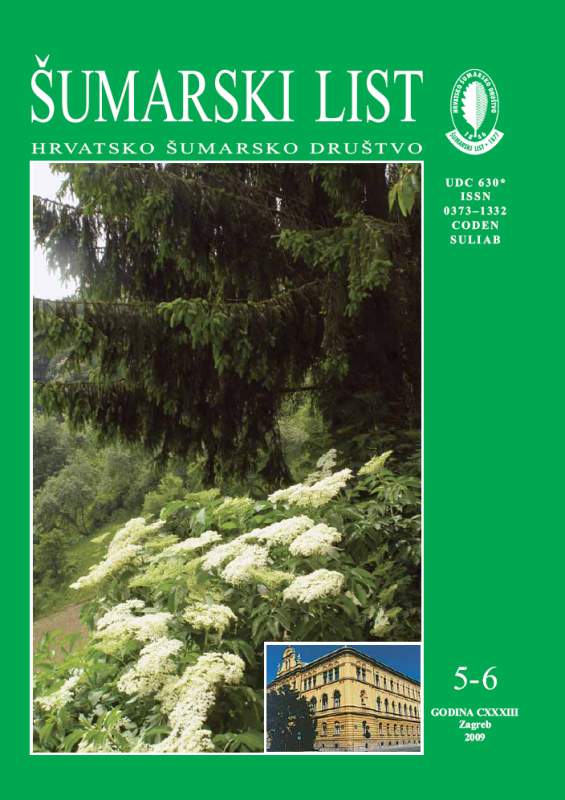
broj: 5-6/2009
pdf (3,4 MB) |
|
||||||||||||||
| RIJEČ GLAVNOGA UREDNIKA | ||
| Branimir Prpić | ||
| HOW TO SECURE THE FUTURE OF YOUNG, NATURALLY MANAGED FORESTS IN CROATIA DURING RECESSION pdf HR EN | 236 | |
| IZVORNI ZNANSTVENI ČLANCI | ||
| Tikvić, I., Ž. Zečić, D. Ugarković, D. Posarić | UDK 630* 429 + 851 (001) | |
| Damage of Forest Trees and Quality of Timber Assortmets of Pedunculate Oak on Spačva Area pdf HR EN | 237 | |
| Trinajstić, I., Z. Cerovečki | UDK 630* 188 (001) | |
| Festuco drymeiae-Fagetum Magic 1978 Association (Aremonio-Fagion) in the Vegetation of Northwest of Croatia pdf HR EN | 249 | |
| Roth, V., T. Dubravac, I. Pilaš, S. Dekanić, Z. Brekalo | UDK 630* 232.3 (001) | |
| Acorn Size of Pedunculate Oak (Quercus robur L.) and Sessile Oak (Quercus petraea Liebl.) as a Factor in Growth and Development of Seedlings pdf HR EN | 257 | |
| Summary: Investigations were carried out on three samples of Peduncled oak (Quercus robur L.) and three samples of Sessile-flowered oak (Quercus petraea Liebl.), of different plumpness (Table 1). Seeding was performed on two locations in November 2003 in the forest nursery of the Division for Nursery Production, Forest Research Institute, Jastrebarsko (45o 40’ N, 15o 39’ E) and in the nursery “Zdenački Gaj” (45o 35’ N, 17o 05’ E), Forestry Office of “Grubišno polje”. At the end of the first vegetation (15th October, 2004) measurement of heights of the investigated samples was performed. At the end of the second vegetation (Autumn 2005) measurements of the heights were performed, and on an average sample determination was also made of the mass of dry matter in the above ground part of the investigated Peduncled oak and Sessile-flowered samples (2+0). Influence of the acorn plumpness on the height of one-year plants (1+0) and two-year plants (2+0) of Peduncled oak and Sessile-flowered oak, was evident on both localities in the nursery part of the test (Tables 1 & 2, 6 & 7, Graphs 3 & 4). Bigger acorns of pedunculate and sessile oak produce one-and two-year old seedlings of significantly greater height. The quantity (mass) of the dry matter in the above ground part of the investigated samples of Peduncled oak and Sessile-flowered oak, at the age of 2+0, also showed marked differences, conditioned by the plumpness of acorn (Table 8, Graphs 5 & 6). According to the acorn size, biomass of dry matter of above-ground parts of seedlings of pedunculate and sessile oak at age of two years can be two to five times greater. Increased ability of sorption in soils with greater clay content is probable cause for lower productivity of soil in “Jastrebarsko” nursery, inspite of its greater content of nutrients (N, P and K). Retention of nutrients on the surface of clay particles makes them inaccessible to the plants, and causes reduced growth of seedlings. Another probable cause of weaker growth of seedlings is the impaired water holding characteristics of soil in “Jastrebarsko” nursery. According to the soil texture, heavier soil in “Jastrebarsko” has a lower aeration in the rooting zone, which together with prolongation of reduction conditions favors inferior water-air conditions in comparison to the “Zdenački Gaj” nursery. All three samples of Peduncled oak and Sessile-flowered oak showed markedly greater heights, as well as the mass of dry matter in the above ground part, in the nursery with lighter mechanical composition of soil. Key words: acorn plumpness; Peduncled oak (Quercus robur L.); plant heights; Sessile-flowered oak (Quercus petraea Liebl.) | ||
| Jakovljević, T., K. Berković, G. Tartari, B. Vrbek, J. Vorkapić-Furač | UDK 630* 425 (001) | |
| Atmospheric Deposition in Forest Ecosystem of Europe and Research of New Methods for Determination of Phosphorus and Ammonia Within a Framework of ICP Forests pdf HR EN | 267 | |
| Degmečić, D., K. Krapinec, T. Florijančić | UDK 630* 156 (001) | |
| Factors that Determine Sex of Red Deer Calves (Cervus elaphus L.): Verification of Current Knowledge pdf HR EN | 279 | |
| Potočić, N., I. Seletković, M. Čater, T. Ćosić, M. Šango, M. Vedriš | UDK 630* 232.3 + 422 | |
| Ecophysiological Response of Sun-Exposed Common Beech (Fagus Sylvatica L.) Seedlings under Different Fertilization Levels pdf HR EN | 289 | |
| Rosavec, R., D. Dominko, D. Barčić, D. Starešinić, Ž. Španjol, K. Biljaković, M. Ožura, N. Marković, D. Bognolo | UDK 630* 432.1 (001) | |
| Analysis of Distribution of Areas Affected by Forest Fires on Island of Brač, Island of Korčula and Island of Rab pdf HR EN | 301 | |
| PRETHODNO PRIOPĆENJE | ||
| Perić, S., J. Medak, I. Pilaš, B. Vrbek, M. Tijardović | UDK 630* 413 + 232 | |
| Initial Research Results of the Possibility of Revitalizing Očura II Querry with Autochthonous Tree and Shrub Species pdf HR EN | 309 | |
| PREGLEDNI ČLANCI | ||
| Konjević, D., U. Kierdorf, V. Njemirovskij, Z. Janicki, A. Slavica, K. Severin | UDK 630* 132 | |
| Wild Boar Tusk Pathology: An Overview of the Current Knowledge and Models of Reparation pdf HR EN | 319 | |
| STRUČNI ČLANCI | ||
| Frković, Alojzije | UDK 630* 156 | |
| The First Hunting Textbook of Bosnia and Herzegovina pdf HR EN | 327 | |


